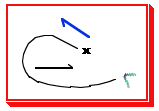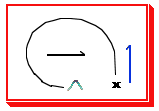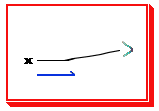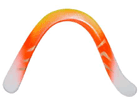Throwing and Catching a Boomerang
The following guide will help you learn how to throw a boomerang so it returns, the best way to catch it when it does, and other fascinating things.
If you can throw a ball, you can learn to throw a boomerang too! Boomerangs are thrown with the same basic overhand throw used in most other sports. With a little practice (and these instructions) you will be throwing and catching your boomerang in no time.
You will find out:
- Where and when to throw
- Basic throwing technique
- Fine-tuning your throw
- Catching your boomerang
- Boomerang maintenance
- Competition and games
Most people have some knowledge of boomerangs. Quite a few remember souvenir or plastic toy boomerangs that they had as a kid. The main thing they remember is that it rarely came back, if it came back at all.
And once your little brother or sister got tired of running and fetching it for you, it was relegated to the bottom of the toy box, maybe taped to a broom stick for hockey, or sacrificed to Dad's lawn mower.
There are two main reasons your boomerang didn't come back:
- Throwing boomerangs is a learned skill and takes practice
- A boomerang is a precise object and is difficult to mass produce
Successfully throwing a boomerang is a learned skill, like hitting a golf ball or throwing a disc. It should take a few throws and maybe even a few throwing sessions before you are able to have your boomerang consistently return to you.
Think about it - you are taking an inanimate piece of carved wood, throwing it 100+ feet away from you, only to have it turn and fly back to you to be caught. A perfectly thrown boomerang is comparable to hitting a hole-in-one in golf - except it is much easier to do and your boomerang is in your hand ready to be thrown again, not a hundred yards away hiding in some hole.
Where and when to throw boomerangs
Throwing Area
Select a large grassy area, clear of trees, bushes, lamp posts, crystal vases, etc. A soccer field, baseball field or a clearing in a park usually work well. Try to make sure that you have at least 60 yards throwing space in all directions. Avoid areas with high weeds or bodies of water because you will probably lose your boomerang. Especially if you are just starting out.
Do not throw in the vicinity of children, livestock, parked or moving cars, buildings with windows, etc.
A mis-thrown boomerang can be dangerous and cause serious injury or damage if it hits something. Once a boomerang leaves your hand you have no control over it. Because a boomerang flies in a curved path, it is hard for a casual by-stander to anticipate which way it is going to go. Yelling "LOOK OUT" immediately after throwing will almost guarantee that your admiring spectators will stampede directly into the path of the on-coming boomerang. Please keep safety in mind.
Throwing Weather
A nice, warm day with little or no breeze is almost ideal for boomeranging. Some boomerangs will not return in a dead calm. Higher winds accommodate heavier boomerangs and different throwing techniques. Gusting winds, or winds that change direction rapidly could cause you to lose control of your boomerang and should be avoided until you have some experience.
Rain ( yes, some of us throw in the rain) will do little to affect the flight of a boomerang, but it may have an adverse affect on the boomerang itself, depending on the finish on your boomerang. An unfinished or poorly sealed boomerang will swell with moisture, possibly cracking the remaining finish or warping the boomerang itself.
Also, throwing with snow on the ground is one of the best ways to lose a boomerang. A boomerang can travel an amazing distance underneath the top crust of the snow, leaving you first, with a white-on-white knife slit to find; and second, a five foot diameter circle to grope in. You may be able to come back in the spring and find it, but chances are you won't. If you do find it, it will most likely be swollen to the size of your arm or shredded by the Park District mower.
If you have several boomerangs, the Park District lawn mower is also a good reason to be careful to leave with all the boomerangs you brought. More than once I have returned to my favorite throwing spot to find chunks of one of my boomerangs scattered over a wide area.
Basic throwing technique
A boomerang is always thrown overhand like a baseball. Never, ever throw your boomerang side-arm. It will climb straight up in the air, then swoop back down and hit you, your friend, or the ground and break in half! Always throw overhand!
There are two basic ways to grip your boomerang, the pinch grip and the cradle grip. The pinch consists of simply pinching the boomerang between your thumb and forefinger, allowing friction to keep the boomerang in your hand during the throw. Snap your wrist at the end of the throw to create spin, and momentum will help pull the boomerang from your hand. The cradle grip is similar to the pinch grip, the difference being that you wrap your forefinger around the front of the boomerang. At the end of your throw, snap your wrist and "pull the trigger" to create spin.
Creating spin is essential for a successful throw. So which-ever grip is most comfortable and allows you to create maximum spin is the one to use.
The boomerang has two arms: the lift or leading arm and the trailing or dingle arm. The boomerang can be thrown from either of these arms.
The most curved side (usually the decorated side like the graphic to the left) of the boomerang must be toward your face with the flat side (graphic on the right) facing away. Otherwise the boomerang will rotate backwards and the airfoils will not generate lift.
Fine-tuning your throw
Getting the boomerang to return
 Direction of the throw, relative to the wind is critical. The boomerang must be thrown across the direction from which the wind is blowing at about a 45degs to 90degs angle. To determine the proper direction of the throw, pick up some leaves or grass clippings and drop them. Observe which way the wind blows the clippings. Face directly into the wind, so it's blowing right into your face. Turn about 60degs or so to your right. The wind should now be blowing from your left to your right. Throw your boomerang in the direction you are facing.
Direction of the throw, relative to the wind is critical. The boomerang must be thrown across the direction from which the wind is blowing at about a 45degs to 90degs angle. To determine the proper direction of the throw, pick up some leaves or grass clippings and drop them. Observe which way the wind blows the clippings. Face directly into the wind, so it's blowing right into your face. Turn about 60degs or so to your right. The wind should now be blowing from your left to your right. Throw your boomerang in the direction you are facing.
Use the key at the right to decipher the following illustrations.
If the boomerang:

Returns and lands in front of you, turn slightly to your left and throw more into the wind.

Returns and lands behind you, turn to your right and face more away from the wind.

Returns to where you are standing but is too high to catch, throw with less arm (softer throw) or stand the boomerang up closer to vertical.

Is headed back in your direction but hits the ground before it reaches you, throw harder or use more layover.

Flies straight out and hits the ground, you need more spin or you've thrown it upside down.

This is what a good throw should look like.
Experimenting with different throws and in differing wind conditions will improve your skill in having the boomerang fly exactly how you want it to. Another tip is to mark the spot you throw from, so if you have to move to catch or retrieve your boomerang, you can see how close it returned to the spot you threw from. Always return to this spot to throw again.
The sport of boomeranging is a developed skill, like throwing a disc or hitting a golf ball. It will take some practice. To take a carved piece of wood and throw it 150 feet away, only to have it turn and fly back to you to be caught, is like having a hole-in-one shot in golf. Except you have to go and get your disc or ball. Your boomerang, on the other hand, is back with you and waiting to be thrown again.
Catching your boomerang
The best way to catch a returning boomerang is to trap it between the palms of your hands. Wait until your boomerang is below shoulder level, then place one hand above and one below your boomerang, "clap" your hands together, trapping the boomerang between. If you want to try one handed catches, stick your hand into the open hole in the center of the spinning boomerang and grab. Try this technique only if your boomerang is well above your head or below your shoulders, because the boomerang can spin off your hand changing directions abruptly, and could strike your head or face.
The flight path of a boomerang changes constantly during a flight. Do not look away from a returning boomerang and expect to find it in the air again easily. If you do need to look away (you trip over your marker) glance quickly in the area you expect the boomerang to be. If you don't see it right away, don't stand there and stare! A boomerang returning at close to eye level is almost impossible to spot and will hurt if it hits you in the face. If you don't spot it immediately, assume the "mystery boomerang position", turn your back, cover your head with your arms , and crouch down. If the boomerang lands on your back, you know it was a good throw.
Boomerang maintenance
Most boomerangs need to be flat to perform well. An up or down warp in either of the arms will radically effect the flight. To check for flatness, place your boomerang on a surface you know to be flat, hold down the apex of your boomerang with one hand and use the other to tap on arms. If you hear a click when you tap in the middle of the arm, you have a down-warp on that arm. If you hear a click all the way down the arm, you have an up-warp. A slight up-warp at the tip is okay. To correct a warp, heat your boomerang over an electric stove element for a few seconds or put it in a microwave for about 8 seconds. Bend the arm in the opposite direction of the warp and hold it until it cools. Recheck for flatness.
prada purfume yachting hat inactive instagram followers prada logo loafer specialty printing services prada sweatsuit men's buy gucci instagram anonymous followers my instagram followers chatgpt cheat sheet italian restaurants in rosemont chatgpt ban chatgpt video versace outlets amazing grace in cherokee native american gucci oficial electric mashman snow helmet chatgpt woke prada purses outlet prada hand bags prada fuzzy bag 600 followers instagram prada cake prada bags nordstroms ember fine jewelry instagram followers audit urchase instagram followers prada orange purse plus followers instagram alexander mcqueen outlet store prada green sneaker trackgram instagram followers chatgpt for windows covered bulletin board manatee high school focus prada saffiano tote prada iconic bag dupe prada bag burberry outlets online instagram ranking followers prada españa kon tiki makeup gucci cost yacht captains hat prada iconic bag prada sizing followers instagram gratis vitton outlet roofing material order form specialty trim sunglass prada dr kiran patel house comprar followers instagram prada crystal skirt prada dog backpack designer sunglass outlet bag prada chatgpt questions prada bottle fila prada chatgpt' my instagram followers prada menswear reflex blue cmyk mashman helmet winthrop red apple tamagotchi game premium shopping outlets pa dgs procurement chatgpt dan mode purse outlet stores prada crossbody dupe shoppremiumoutlets.com opoli bondys buy prada glasses prada women's silicone pregnancy belly firehouse subs carrollwood prada bags on sale outlet prada nose pads chatgpt app中文 cost of chatgpt prada shoulder bags mutual instagram followers pantone indigo blue manuel prada 1k instagram followers cheap prada sneakers colored bulletin boards
Nicks and gouges in the wood can be filled with wood putty, sanded smooth and re-coated with polyurethane to seal against moisture.
Happy throwing!
These instructions are based on my own experience in throwing boomerangs and in teaching others how to throw, and is written for beginning right handed throwers but a left handed thrower with a left handed boomerang can also use these instructions. A left handed boomerang turns to the right, so the flight path and throwing techniques are a mirror image of the right handed ones.


